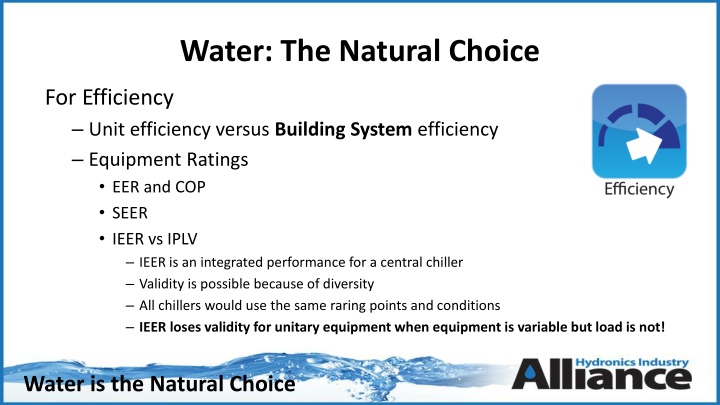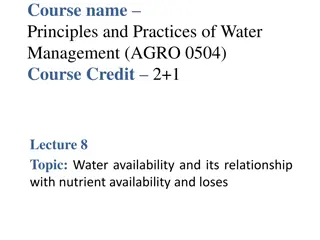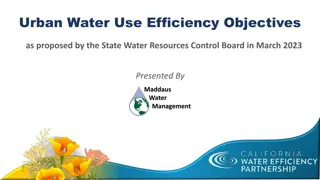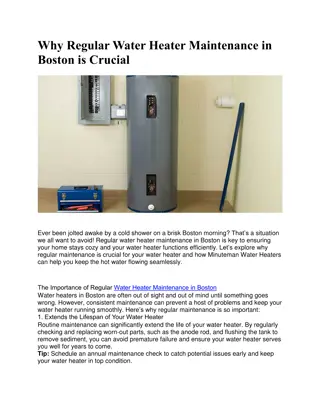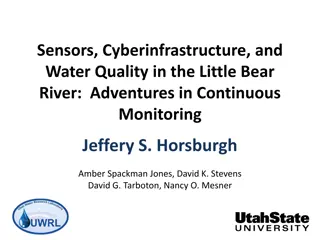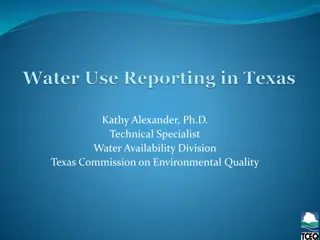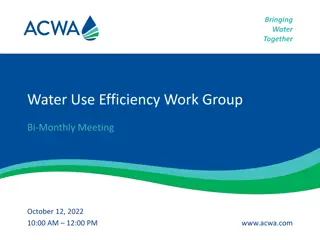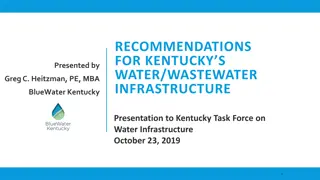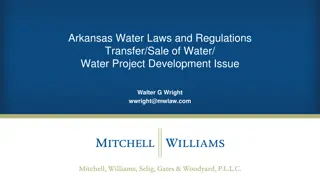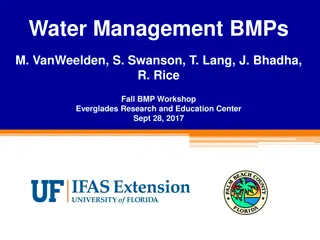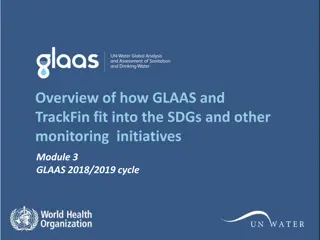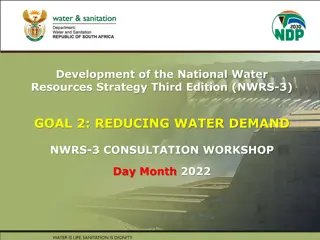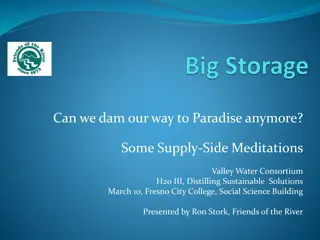Water: The Natural Choice
Water is highlighted as the ideal choice for efficiency in building systems, focusing on the comparison between unit efficiency and building system efficiency. Equipment ratings such as EER, COP, SEER, IEER, and IPLV are discussed, emphasizing the importance of integrated performance for central chillers. The validity of IEER and its limitations for unitary equipment are explored. Additionally, the significance of SEER and IEER in relation to adjusted ratings for actual building operation is examined, particularly in residential settings. The testing procedures and considerations for SEER as a benchmark for comparison in residential split units are also outlined.
Download Presentation

Please find below an Image/Link to download the presentation.
The content on the website is provided AS IS for your information and personal use only. It may not be sold, licensed, or shared on other websites without obtaining consent from the author.If you encounter any issues during the download, it is possible that the publisher has removed the file from their server.
You are allowed to download the files provided on this website for personal or commercial use, subject to the condition that they are used lawfully. All files are the property of their respective owners.
The content on the website is provided AS IS for your information and personal use only. It may not be sold, licensed, or shared on other websites without obtaining consent from the author.
E N D
Presentation Transcript
Water: The Natural Choice For Efficiency Unit efficiency versus Building System efficiency Equipment Ratings EER and COP SEER IEER vs IPLV IEER is an integrated performance for a central chiller Validity is possible because of diversity All chillers would use the same raring points and conditions IEER loses validity for unitary equipment when equipment is variable but load is not! Water is the Natural Choice
Unit Efficiency Sustainable for life EER is simple Output of unit in BTU divided by input power Every unit, a chiller, a rooftop, unitary equipment that uses refrigerant has an EER Energy Efficiency Ratio EER is BTU per hour output in cooling/power input Example a one ton unit delivers 12,000 Btuh/1000 watts for fan and compressor = 12 EER Water is the Natural Choice
Unit Efficiency (be careful) Not a building Why SEER and IEER? Adjusted performance to show potential blended rating Adjusted to include part load operation over a specific range of outdoor air temperatures Because outdoor air temperature affects both capacity and efficiency of an outdoor condensing unit. SEER Seasonally adjusted used primarily for residential equipment IEER Integrated to include both seasonal and part load per formula Problems How to apply adjusted ratings to actual building Operation of equipment outside ratings Water is the Natural Choice
SEER why Residential is more comparable Applied residentially based on the fact that the majority of residential units are installed very similar. Actual varies by size, location and weather, but all are tested to the same weather so they can be compared to each other. A condenser outside An air hander inside And a refrigerant line set between them Pre-charged with refrigerant Factory-sealed Purchased from wholesaler or unit manufacturer Water is the Natural Choice
SEER a test for comparison All manufacturers of residential split units form a committee at AHRI Air Conditioning, Heating, and Refrigeration Institute Those manufactures agree to apply a Specific Seasonal adjustment to their equipment EER. All members test to an agreed performance with matching Condenser, Air handler, and line set containing refrigerant A package tested to a fixed set of conditions Water is the Natural Choice
SEER SEER is like the MPG sticker on your car. It is not what you will expect to get It is a comparison of manufacturers of like models To a prescribed set of conditions SEER is the same type of process of comparison It does not work commercially and is not used Too many Variables Water is the Natural Choice
Whats wrong with SEER? Fixed refrigerant lines and fixed weather conditions Commercially you need a professional because: The buildings are all different The installations have many variations The occupancy and use of the building are not typical Energy Efficiency Ratio (EER) that can be modeled EER is the unit output versus power consumed at a specific point as a base Not what you expect in the building - a common comparison point Water is tested at design operating condition air is not And all Manufacturers use EER at the same conditions Water is the Natural Choice
What is IEER? Another way to compare performance of equipment among manufacturers of identical equipment in a lab It is: Like Equipment to Like equipment not building systems Like units are tested at the same conditions per a lab s capability The prescriptive conditions are NOT how your building operates IEER should be applied to a total building not a unit. IEER is not valid for units with static loads (especially when occupied during the heat of the day). A building has a system a condensing unit is not a system Water is the Natural Choice
Key point Certified vs Actual IEER and the test is created by the MEMBER manufacturers The test results are monitored by AHRI AHRI does not create the test points AHRI verifies that the member company s test to the standard the Manufacturers created. The standard test has to be reproducible in a laboratory NOT your building! Location (Weather) or Operation Split units cannot perform as tested because they are not shipped or installed as tested or operate as tested Water is the Natural Choice
IEER Based on unit capacity not load Adjusted Performance average IEER = (0.020 * A) + (0.617 * B) + (0.238 * C) + (0.125 * D) Where: Both air delivered and outdoor air temperature are reduced (02.0%)A = EER at 100% net capacity at AHRI standard rating conditions (95 F) (61.7%)B = EER at 75% net capacity and reduced ambient (81.5 F for air-cooled) (23.8%)C = EER at 50% net capacity and reduced ambient (68 F for air-cooled) (12.5%)D = EER at 25% net capacity and reduced ambient (65 F for air-cooled) Split DX - with only 25 feet of refrigerant tubing FLAT no lift Room is always 80 degrees increasing equipment capacity as measured by the Laboratory; there is no part load if 80 in the space! Water is the Natural Choice
Problem with IEER when is a 12 a 21? Actual screen shot from AHRI directory EER is the unit power consumption vs output at one point IEER is adjusted Not to your building to a test Confusing? Misleading? Yes, Benchmarking is the friend of Hydronic Systems because they deliver at the utility bill. Water is the Natural Choice
Hydronic Advantages With Water the system operates inside design parameters The lowest cost way to transport energy Hydronic systems maintain efficiency You choose air delivery or radiant delivery Water-cooled units are more efficient because of high heat transfer capability Terminal units receive controlled Design water temperatures It is water it can be variable flow and temperature Water is the Natural Choice
High Heat Transfer? Cooling a hot skillet - What is Faster? Wave around in 70 degree air Water even 100 degree dishwater Water is the Natural Choice
Protect your investment in Efficiency Water always Wins Equipment and components exceed 20 years Options and Choice fit the budget Options and Choice meet Owner Requirements Options and Choice ensure system life Options and Choice ensure system integration for the whole building Forward and Backward compatible For the Life of YOUR BUILDING Water is the Natural Choice
Water: The Natural Choice www.hia-c.org Water is the Natural Choice
